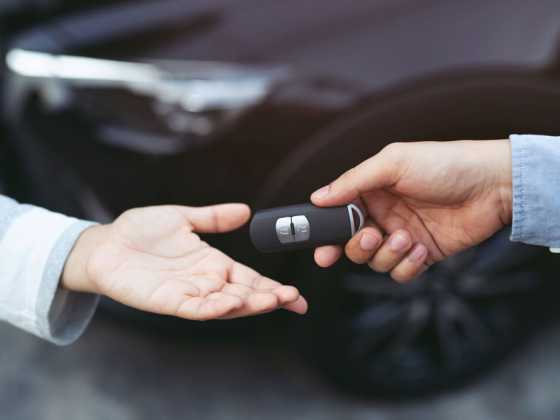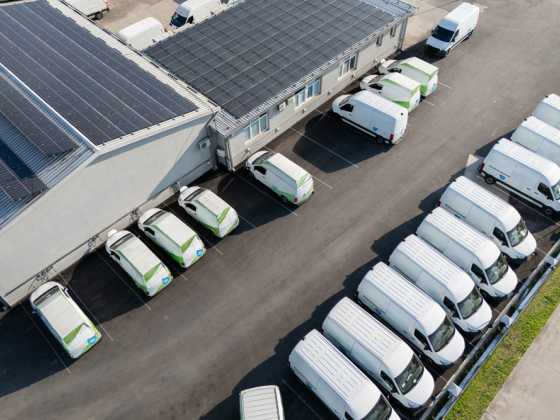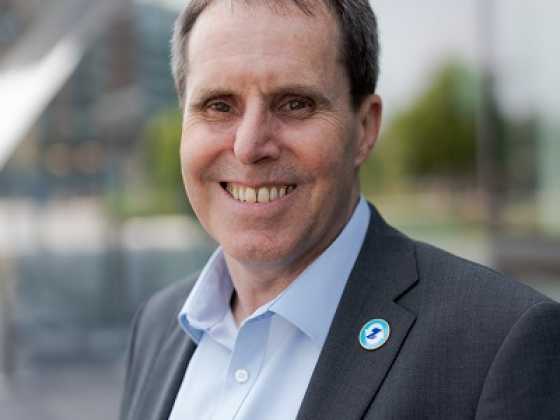Expert Panel: Public Sector Fleet Decarbonisation

The public sector is expected to lead by example when it comes to decarbonisation, but must also continue to deliver vital services without disruption. Add to this the diversity of public sector operations and vehicle usage, and decarbonising public sector fleets is a complex task. Our expert panelists Steve Beadle, Laura Lancaster and Simon West-Oliver unravel the challenges and offer some guidance on smoothly transitioning to zero-emission transport
Panellist biographies below
The public sector is expected to lead by example when it comes to decarbonisation. Starting from the top, central government has a target to decarbonise the entirety of its central car and van fleet to zero emission
vehicles by 2027.
Local authorities have the double challenge of having to decarbonise their own transport operations, and making their own local areas EV-friendly, by way of installing electric vehicle charging infrastructure and developing other incentives to promote adoption.
Other vital areas within the public sector, such as healthcare and emergency response teams, must also decarbonise. Needless to say, these have their own unique challenges that require careful consideration.
Steve Beadle, head of 0Zone at The Grosvenor Group says: “Public sector bodies have a very diverse and wide range of vehicles, making their move to electric quite complex, and their actions are under far greater scrutiny than the private sector due to it being taxpayers money. If we look at the full breadth of public sector vehicles, it ranges from staff providing care in the community and driving small cars to people’s homes, through to refuse collection vehicles and other electric HGVs. Then if we expand it further, we are looking at the emergency services, with the Police having an enormously diverse fleet mix, the ambulance services and the fire brigade.
“On the one hand, the public sector is expected to lead by example by having a zero emission fleet, particularly in large towns and cities where private motorists and businesses are being penalised for having higher emission vehicles, for example through low emission zones.
“But on the other hand, the public sector is also under huge pressure to meet its obligations to providing public services, and this can become more challenging when transitioning to electric. If we look again at how diverse public sector fleets are, it is relatively straightforward for someone providing care in the community, driving relatively low mileages every day, to move to an electric car. However that is a very different scenario to a heavily armoured police vehicle responding to emergencies.”
Summing up the challenge, Steve says: “It isn’t just about finding suitable vehicles to enable public sector bodies to continue to meet their obligations with zero emission motoring, it is also about the charging infrastructure, managing public expectations, balancing the public purse, and implementing a change programme whereby public sector employees, especially in critical services, believe that they will be able to do their job
in an electric vehicle when they have been used to driving a petrol or diesel for so many years.”
Complex operations
Laura Lancaster, vice president of EV Networks & Partnerships at Fleetcor, the company that owns AllStar Business Solutions, agrees that diversity of public service operations makes a one-size-fits-all solution for decarbonisation difficult. Laura says: “The public sector covers a huge variety of fleets and departments; ranging from company cars, vans for NHS transport, blue light ambulance services, police services, to local council service vehicles such as refuse, waste management and speciality environmental agency vehicles. All of these fleets are used in a different way, some required 24 hours, some travel large distances across counties and some in urban areas. The type of specialty equipment and the energy to power the equipment varies as well when looking at fire services, ambulances and heavy duty vehicles. Essentially, fleets have to be fit for purpose to deliver their essential services – impact on service and down time is not an option for some of these fleets.”
Another problem is the often disconnected nature of public services. Laura explains: “Another challenge is the fragmentation of each part of the public sector, with the variety of services they conduct. It’s also tricky pinpointing where the responsibility lies within each service. Is it the facilities and estate, the fleet manager or human resources? With our own public sector customers, we are working with them to help deliver a standardised solution over multiple sites in the same trust or county which have historically implemented different charging infrastructure. The “fragmented” approach is later causing challenges to managing the infrastructure across sites, as well as consolidating costs and the consumption of the electric vehicles deployed.”
“Public sector is also dealing with limited budgets an staff and drivers under strain.They are more scrutinised when it comes to spend and KPIs – all which will be impacted by decarbonisation initiatives,” Laura adds.
Fit-for-purpose above all
Simon West-Oliver, director of sales, AssetWorks agrees that the diversity of public sector fleets and their vital nature means that decarbonisation can be problematic. He says: “Public sector fleets are responsible for delivering essential services, such as emergency response, waste management, and public transportation. These services often require specialised vehicles with specific capabilities and equipment. Decarbonising these specialist vehicles can be challenging, as alternative fuel options may not yet be readily available or suitable for their specific functions. Finding suitable decarbonisation solutions that maintain the functionality and effectiveness of these vehicles is a key challenge.”
The public sector generally faces funding conflicts, as Simon points out: “The public sector often operates within constrained budgets, and fleet decarbonisation efforts must compete with other funding priorities. The higher upfront costs associated with purchasing or transitioning to low-emission vehicles can pose financial challenges. Limited budgets may slow down the pace of fleet decarbonisation, requiring careful planning and exploration of funding options or grants to support these initiatives.
“What’s more, public sector spending is subject to scrutiny and accountability. This means that every investment in fleet decarbonisation must be justified and demonstrate clear value for money. The need to balance the environmental benefits of decarbonisation with the financial implications can make decision-making more complex and require robust business cases and performance evaluation.”
Infrastructure issues could also be a barrier for the public sector: “Public sector fleets often require dedicated or specialised infrastructure, such as charging stations for electric vehicles or hydrogen refuelling stations. The availability, accessibility, and cost of such infrastructure can impact the feasibility and pace of fleet decarbonisation,” Simon says.
But these challenges can be overcome with the right approach and the right support. Simon says: “Addressing these challenges requires a holistic and tailored approach that considers the specific needs of the public sector. Collaboration between fleet managers, government agencies, industry experts, and technology providers is essential to overcome these obstacles. Innovative financing mechanisms, partnerships with private sector stakeholders, and continuous monitoring and evaluation can help the public sector navigate the challenges and successfully decarbonise their fleets while delivering essential services to the community.”
Building a decarbonisation strategy
So how can public sector organisations begin with their fleet decarbonisation in a way that deals with these aforementioned challenges?
When it comes to avoiding downtime from charging an electric vehicle, something that many public sector fleets cannot afford, Laura Lancaster from Fleetcor / Allstar says that there are various strategies and not one solution fits all: “Buses could charge overnight, for example, and others could charge between jobs or in natural downtime, such as while ambulances are waiting at A&E,” suggests Laura. “Using rapid networks, such as Allstar’s where there are 3,000 rapid charge points, can also help avoid downtime,” she adds.
Choosing vehicles with a large range or vehicles with a battery that charges quickly is also advisable. Laura shares an example: “Electric Ford Mustang Mach-E cars are being used by the London Ambulance services for paramedics responding to 999 emergencies. It’s reported that the battery takes just 40 minutes to charge up to 80 per cent which allows the car to travel more than 300 miles, which is about ten times further than an ambulance would normally cover on a shift.”
Selecting the vehicles that could easily switch to electric is a good way to kick off decarbonisation plans, says Laura. These could include company cars, salary sacrifice, non-essential services in the emergency sector, electric street sweeper, electric vans for services, and so on. Telematics is a good way of identifying which vehicles to transition.”
Another way to start the decarbonisation journey is to work with industry to build and trial zero-emission transport solutions, believes Laura. West Midlands Ambulance Service, for example, is trilling an all-electric ambulance, known as the Electric Dual Crewed Ambulance (E-DCA), in front-line services.
Careful planning
Steve Beadle, head of 0Zone at The Grosvenor Group says that the level of scrutiny the public sector is under adds another pressure to fleet decarbonisation. As such, it’s vital to have a clear strategy. Steve advises: “It’s important to map out all of the vehicles, and look at where they are driven, what kind of activity they are undertaking, what charging infrastructure is either in place now or being developed, and can they be replaced by an electric vehicle, and over what time frame.
“By doing this, an EV switch programme can be mapped out ranging from the quick wins, where the conversion to electric is relatively simple, through to the more challenging where the move to electric is far more difficult.”
And don’t be afraid of a gradual transition, Steve says: “A wholesale move to electric might not be possible, and it is important to identify which vehicles can become fully electric, and which vehicles cannot.”
“Where full electric is not feasible, perhaps due to the mileages being driven, the type of vehicle required, or there being a lack of suitable electric models available, a hybrid model or low emission petrol or diesel might be the interim solution.
“Flexible leasing is far more available nowadays, and there should be no reason why a public sector body couldn’t negotiate some form of short term lease on ultra low emission vehicles while waiting for an electric alternative to become available - rather than having to commit to another three or four year lease.
“Another option, which is something Grosvenor has done in the past, is agree as part of a contract hire arrangement that if a suitable electric vehicle becomes available, the current lease arrangement can be terminated without penalty to facilitate that move to an electric vehicle more quickly.”
Ask the right questions
When switching to EVs, very careful planning is needed, and every single vehicle needs to be mapped out, advises Steve. So what questions should be asked? Steve suggests the following: What does that vehicle do? Over what geographical area does it operate? What is the charging infrastructure in that area? What is the availability of suitable electric vehicles? Is there any way the use of that vehicle can be changed to accommodate an electric vehicle or does an electric vehicle need to perfectly meet the requirements of that job role?
Other questions to ask are: What type of loads does the vehicle carry? When does the lease contract come to an end? Who is driving the vehicle and what actions need to be taken to educate them about doing their job in an electric vehicle? How resistant to change will they be? If it is a shared vehicle, how will that be managed in terms of usage and charging? To what extent can charging be carried out at work, using public charges or at employees’ homes? If drivers are using their own vehicles for business use, what can be put in place to encourage the conversion of that fleet to electric?
“It is questions such as these that need answering as part of an EV transition strategy,” says Steve.
Understanding your fleet
Simon West-Oliver from AssetWorks advises that to avoid decarbonisation pitfalls, it’s essential first to understand duty cycles. He explains: “Conduct a comprehensive analysis of the duty cycles and operational requirements of the fleet. This includes assessing vehicle usage patterns, mileage, payload capacity, and specific functions. Understanding these factors will help identify which vehicles are best suited for early-stage decarbonisation and prioritise efforts accordingly.
“Research and leverage available funding options to support fleet decarbonisation. Governments and organisations often offer grants, incentives, or financial programs specifically for transitioning to low-emission vehicles. Identifying and applying for these opportunities can help mitigate the financial burden of adopting cleaner technologies.”
Careful consideration of charging requirements is also vital. Simon says: “Evaluate the charging infrastructure needs for electric vehicles (EVs) in the fleet. Consider factors such as on-site charging stations, high-power charging capabilities, and the availability of public charging infrastructure. Developing a charging infrastructure plan that aligns with the fleet’s operational requirements will ensure reliable charging access without disrupting essential services.”
Other advice offered by Simon is to consider taking part in pilot projects and trials, and collaborating with industry experts, who are happy to offer support. Road maps and targets also help focus mindsets and accelerate plans.“Create a comprehensive roadmap for fleet decarbonisation that includes specific targets and milestones. This roadmap should consider the unique characteristics and challenges of the fleet, along with potential technological advancements and infrastructure developments. Setting clear targets and tracking progress will ensure a structured approach and maintain momentum towards achieving long-term decarbonisation goals,” Simon from AssetWorks adds.
Eliminating grey fleet
Many public sector employees use their own cars for business travel, which is known as ‘grey fleet’. Grey fleet vehicles tend to be older, more polluting, and may not be serviced as regularly. It can be difficult to supervise them too. With recent travel disruption, such as train strikes, more drivers may be drawn to using their own car for work.
So how can the public sector reduce this reliance on ‘grey fleet’? Laura Lancaster from Fleetcor / Allstar, says: “Grey fleet may be one of the hardest areas for the public sector to decarbonise. Grey fleets have always accounted for a large portion of the NHS travel with district nurses, health services using private vehicles for work travel.
“If the NHS, for example, continue to have grey fleet, they are reliant on employees to change their vehicles ahead of time to meet the decarbonisation measures. Salary sacrifice schemes are widely encouraged in the NHS, but is the incentive enough for the health professionals to switch, especially when pence per mile schemes are well paid in ICE vehicles.
“A change to company car fleet would be the most effective way to do this, but this does come with budgeting consequences for Trusts. The solutions for company car drivers has been tried and test by the private sector, with a solution like what Allstar
offers for businesses to pay for their electric charging on-the-road via a single card and their home charging directly through the drivers energy supplier so staff are never out of pocket.
“Sustainability reporting may bring the change from grey fleet to company cars into fruition in future years - with the inclusion of grey fleet in those numbers and as the targets and commitments dates’ drawer closer.”
Laura also points out that much of the NHS is encouraging other mobility solutions and active travel for their staff, such as pool e-bikes, walking, cycling, and public transport.
Greener business travel
Adding to this advice, Steve Beadle from The Grosvenor Group says: “The implementation of an electric vehicle salary sacrifice scheme is something public sector bodies should be looking at. This is by far the cheapest way for a driver to fund an electric vehicle as it is up to 40 per cent cheaper than a personal lease. That should not only just be put in place, but also promoted and communicated widely across the public sector body to maximise the uptake with employees.
“Car sharing schemes are also a good way of reducing the use of grey fleet vehicles. This can either be an in house operated scheme, whereby an ultra low emission or electric pool fleet is used by employees for occasional travel. Alternatively public sector bodies could sign up to a managed scheme of car sharing.
“Mobility as a solution (MaaS) is another strong option, offering an app that will enable employees to get from A to B using public transport in the most efficient way possible, and offering a straightforward and simple booking process. Of course this will not be suitable for everybody, particularly for employees who need to carry essential equipment etc, however it is certainly an option to reduce the number of grey fleet journeys for meetings etc.
“Finally, the need to travel to meetings and appointments has been significantly reduced due to the advent of online meetings, and anyone travelling to an appointment using their own vehicle should really need to justify why they need to go in the first place and why that meeting cannot be conducted over Teams or Zoom.”
Summarising the problem, Steve says that ultimately, policies need to be put in place so grey fleet isn’t a common option. He says: “Ultimately, reducing the use of a grey fleet vehicles becomes a carrot and stick type of operation. The carrot being incentives to move to electric vehicles or not use your own vehicle for business use as much. The stick being methods of discouraging the use of higher emission grey fleet vehicles, such as giving priority parking to those who car share or drive zero emission cars, as well as challenging the amount of use of grey fleet vehicles generally. Because at the end of the day many drivers like to use their own vehicle for business use as much as possible because of the strong mileage reimbursement. This can lead to higher grey fleet use than is necessary and policies need to be put in place to ensure that only essential travel is made in drivers own vehicles, and that all travel must be in ultra low emission or electric vehicles (through car sharing / the use of pool vehicles) or using public transport, unless it cannot be avoided.”
Incentivising other ways to travel
Reducing reliance on “grey fleet” vehicles, where public sector employees use their own cars for business travel, requires implementing various strategies and promoting alternative transportation options, says Simon West-Oliver from AssetWorks. Simon agrees that establishing electric vehicle (EV) salary sacrifice schemes is a very successful way to address the problem. “EV salary sacrifice schemes incentivise employees to switch to electric cars by providing them with affordable access to clean and low-emission vehicles for both business and personal use,” says Simon.
Other ways to reduce staff use of own vehicles is to establish a pool car system or introduce car clubs. Simon says: “Pool cars can be strategically located at convenient points, making them easily accessible for employees. By using pool cars instead of personal vehicles, the organisation can better manage and control vehicle emissions while reducing the wear and tear on employees’ private cars.
“Likewise, working with car-sharing or car club providers can offer employees an alternative to using their own cars for business travel. Car club schemes allow employees to book and use shared vehicles on an as-needed basis. This reduces the need for employees to rely on their personal vehicles, promotes efficient use of vehicles, and encourages a shift towards shared and sustainable transportation options.”
Promoting active travel, public transport and having flexible working arrangements in place can also help curb grey fleet usage, adds Simon.
Rolling out infrastructure
A report last year by Liberty Charge showed only 14 per cent of local authorities have dedicated EV infrastructure staff, such as those working on the planning, commissioning and implementation of charging infrastructure. The report also showed that one third of local authorities have no formal EV infrastructure plan in place, and 44 per cent do not expect to complete it within the next three years. Some of the difficulties cited in the report include budgetary issues, regulatory restraints, resident reticence, logistical difficulties, lack of guidance regarding location of charge points and low density of EV ownership.
Steve Beadle from The Grosvenor Group, believes the study from Liberty Charge was concerning. He said: “The study suggested that local authority strategies are failing, with only 10 per cent (30,290) of the 300,000 charge points wanted by government so far installed.
“In fact, only 800 new chargers are being added to the public network per month, and to meet that target of 300,000 by 2023 the installation rate needs to increase to 3,130-a-month, which is a rise of 288 per cent.
“The research by Liberty Charge also found that 75 per cent of local authorities interviewed quoted budgetary issues as a barrier to infrastructure adoption. And a further 59 per cent pointed to a lack of guidance from central government as to where charge points should be located as the key reasons the installation rate is falling behind.
“It goes without saying that this is a real problem, because if the infrastructure falls short, then this will hamper the ability to effectively operate electric vehicles in the public sector, the private sector, and for private motorists.” To remedy this, Steve believes better communication and collaboration is needed. He explains: “There should certainly be greater collaboration between the local authorities with both public and private sector bodies in their area, in terms of understanding their future requirements, as there appears to be little dialogue (if any) at the moment.
“For example, Grosvenor Leasing is the UK’s largest privately-owned contract hire and fleet management provider in the UK, and we have expertise on electric vehicles and charging infrastructure. We are surprised to have had no contact or dialogue with our local authority and I would assume that this is the same for other local businesses in our area running large volumes of vehicles.
“I also feel the Government needs to pull together a far more cohesive approach to building an EV infrastructure. For example, as of June 15th, 2022, building developers were required to ensure that electric vehicle charging points are now installed within new-build homes, new-build workplaces, supermarkets, and buildings undergoing major renovations.
“Initiatives such as this are key to supporting local authorities in developing local charging infrastructures, particularly now that an increasing number of commercial vehicle fleets are converting to electric.
“For car drivers, the ability to home charge has underpinned a lot of company car and private motorists’ ability to have an EV, but in the commercial vehicle sector workplace and public charging are going to be key – and the government and local authorities will need to step up and help, for both the public and private sectors.”
Joined up working
Laura Lancaster from Fleetcor / Allstar raises the issue of fragmentation in the public sector, and a lack of a cohesive approach to EVs is one of the biggest challenge they see at Allstar. She says: “Decarbonisation and sustainability is generally spread over several roles and departments. Budgets fall into different areas of where the need might be, for example with a fleet manager vs facilities and estate who would look after their EV infrastructure.
“This spread creates a couple of issues. The people responsible for one area are not seeing the full picture or have a vested interest elsewhere, for example, deploying different hardware in different sites can mean the end-to-end solutions doesn’t work.
“Expertise in relations to decarbonisation or EV transition is often lacking as they are not accountable for the whole picture and it is not their full time role.
“The creation of sustainability managers across the public sectors would certainly help improve what is happening now and accelerate the transition over the coming years. This role has increased in the corporate private sector, but not from our experience in the public sector.
“The Greener NHS team has assigned Regional Senior Responsible Officers in each of the seven NHS England and NHS Improvement regions to deliver the net zero commitments. These roles cover a variety of areas such as estate and facilities, supply, food, and travel and transport.”
Laura adds that the public sector can use the expertise of companies externally, when planning and commissioning EV infrastructure. And funding support is available through the government, such as the Local Electric Vehicle Infrastructure (LEVI) fund and £50m funding to support and upskill local authorities on public chargepoint planning and tackling local challenges.
Invest in EV infrastructure staff
Taking on this point about training, Simon Oliver-West from AssetWorks believes it’s important local authorities have funding for training and dedicated staff. Simon says: “Local authorities require financial support to train and employ dedicated EV infrastructure staff. This funding can be used to provide training programs to enhance the knowledge and skills of existing staff or recruit new professionals with expertise in EV infrastructure planning, commissioning, and implementation. Having dedicated staff will ensure efficient management and effective deployment of EV infrastructure projects.
“Likewise Local authorities need financial resources to invest in the installation of EV charging infrastructure. Funding programs or grants specifically aimed at supporting local authorities can help cover the costs associated with infrastructure planning, procurement, installation, and maintenance. This financial assistance will enable local authorities to expand charging networks, establish a robust infrastructure backbone, and accelerate the adoption of EVs within their jurisdictions.”
Collaboration with suppliers and industry partners is also key to EV infrastructure success. Simon explains: “Local authorities should receive support and guidance from EV infrastructure suppliers and industry partners. These stakeholders can offer expertise, technical knowledge, and best practices in designing and deploying charging infrastructure. Collaboration can help local authorities make informed decisions, select suitable technologies and suppliers, and ensure the successful implementation of infrastructure projects.
“What’s more, establishing platforms for sharing best practices and facilitating knowledge exchange among local authorities can be immensely valuable. Regular conferences, and networking events can provide opportunities for authorities to learn from one another’s experiences, discuss challenges, and share strategies. This approach can expedite progress and promote standardisation across different regions.
“Having policy guidance and access to data and research will also help local authorities be better equipped to roll out EV infrastructure effectively. These support mechanisms will help accelerate the transition to electric mobility, foster sustainable transportation systems, and contribute to the decarbonisation of the transport sector,” added Simon.
Expert Panellists:
Steve Beadle, head of 0Zone, The Grosvenor Group
Steve Beadle is head of 0Zone, the Grosvenor Group’s innovative and market leading solution to help companies navigate their way smoothly towards ultra-low emission and electric vehicles. Steve joined the Grosvenor Group in 2012, and is well-known for his clear and inciteful advice for companies with car and light commercial vehicle fleets looking towards their zero emission futures.
Laura Lancaster, Vice President of EV Networks & Partnerships, Fleetcor / Allstar
Laura specialises in helping fleets transition to EV charging payments simpler and more efficient than ever. Her global role means she builds local, meaningful partnerships in order to achieve this. Fleetcor’s portfolio of brands automate, secure, digitise and manage payment transactions, helping fleet operators manage their mixed fleets in their transition to EV.
Simon West-Oliver, Director of Sales, AssetWorks
Simon West-Oliver has over 30 years of experience in the fleet industry. He pioneered some of the early telemetry solutions as well as launched several software solutions to help organisations acquire, manage, maintain, and dispose of fleet assets in a timely and efficient manner. Simon’s wealth of experience supports fleets in managing their assets by providing sustainable change with decarbonisation planning, digitalisation in workshops, embracing a circular economy and managing environmental and social compliance.






